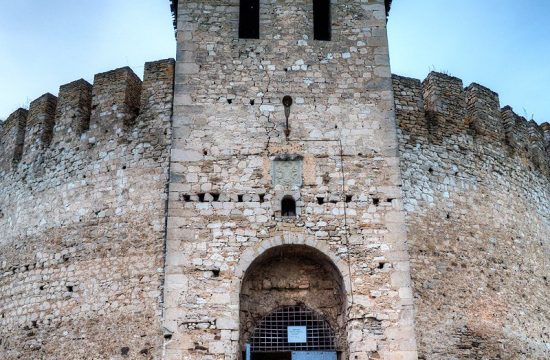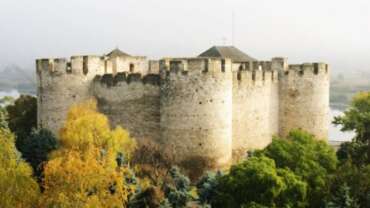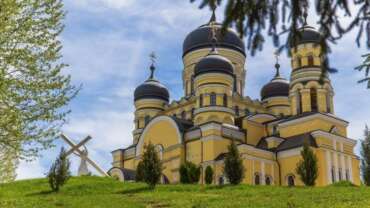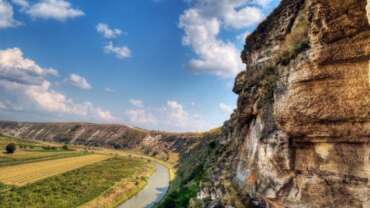Sights & Attractions in Moldova
Old Orhei Historical and Archaeological Complex
Old Orhei (Romanian: Orheiul Vechi) is a historical and archaeological complex, located in Trebujeni, at 60 kilometres (37 mi) north-east of Chişinău, on the Răut River.
The ancient city Old Orhei – a unique natural and historical complex in the open air. It organically combines the natural landscape and vestiges of ancient civilizations. As a result of enormous archeological excavations here there were discovered the cultural layers of different epochs such as – the Paleolithic, Eneolithic, and Iron Age. The culture of Geto-Dacians of Early and Late Middle Ages is represented by the rests of earthen and wooden fortresses of Geto-Dacian period and the traces of two medieval towns – Shehr al-Djedid town of the Golden Horde period and the Moldovan town Orhei.
UNESCO World List of Heritage
Analyzed in the context of the UNESCO World List of Heritage the Cultural Landscape Orheiul Vechi can be included as a mixed site, which disposes unique elements of the natural and cultural heritage.
Serpeni Headbridge Memorial
40 km east of Chisinau, on the right bank of River Nistru one can find this very Memorial of historical and national importance, which was erected in the memory of the heroes who died during the Iasi-Chisinau operation of 1944 meant to free Chisinau of the fascist occupation. The Serpeni battle was one of the cruelest in the World War II history even if it represented just a small episode of the war.
This memorial, the construction of which was started during the Soviet period, is situated on a piece of land which in 1944 was the battle place of only 8 km and 3 km downward. The building is made of such elements as: a stylized altar, on one side, which has a marble safe in the middle, erected in the church, with granite plaques engraved with 11 thousand names of heroes that had sacrificed their lives on this small piece of land near Nistru. In the middle one can see the eternal fire which guards two high pillars connected by a cross at the top, the cross guarding the memory of the heroes that never lost their courage when protecting this land. There is also a high tower bell on a picturesque background of Nistru, which reminds of the Moldavian history and respect for older generations.
An excursion to this place, which has both historical and natural reminiscences, offers the chance to emerge in the historical past and to be served at the pensions in the village, which will contribute to getting acquainted with the culture and traditions of the Moldavian people.
Soroca Fortress
In the medieval period the fortress of Soroca was part of a huge Moldovan defensive system, which comprised four fortresses on the Nistru river, two on the Danube and another three in the northern part of the country. With this “stone belt of fortresses”, the country borders were well protected. Soroca fortress was built at the Nistru river crossing, on older fortifications. In 1499, on the order of Stefan cel Mare, a square wooden fortress was built, on the site of a former Genovan fortress called as Olihonia (Alciona).
Between 1543–1546, while Petru Rares ruled the country, the fortress was completely re-built in stone, and in the shape one can see it today – a perfect circle, the diameter of which is 37,5 m and with 5 bastions situated at equal distances. When designing the fortress the builders incorporated the supreme law of harmony “the golden section”, which makes the fortress unique among examples of European defensive architecture.
Soroca’s fortress is also famous for being the place where the Moldovan army, commanded by the famous statesman Dm. Cantemir, and the Russian army, led by the Tsar Petru I, met and consolidated their forces during the Prut campaign against the Turkish hordes in 1711. Along history, the fortress has been visited by Bogdan Hmelnitski, Timush Hmelnitski, Alexander Suvorov, and others. The fortress is the only medieval monument in Moldova, which has been preserved entirely as it was designed by its builders. Above the entrance gate one can visit the small military church.
The Thanksgiving Candle
The Candle of Gratitude Monument is one of the best monuments in Moldova. The monument is built on the rocks over the Nistru River. It is also considered as a very special work of art for another reason. It is actually built in the memory of the cultural monuments in Moldova that were destroyed in the past. Time stands still when it passes through this monument. It is a silent witness of many hopes and agonies, dreams and hard works of many past generations.
The Candle of Gratitude Monument pays homage to all the heroes of the country who always worked to preserve the culture and tradition of Moldova. They did not just secure their culture but also showcased the true colors of Moldavian tradition and history before the world. In another way round, the monument as well as these safeguards of Moldavian tradition paid a tribute to the forefather of their literature; the anonymous writer of the poem “Miorita”.
This national monument was the brain child of a famous Moldavian classical writer Ion Durta. This man always had a deep respect for the tradition and culture of Moldova. He wanted to pay homage to their ancestors who worked so hard to preserve the Moldavian culture. The idea of making a monument came to his mind some twenty years ago but the project was inaugurated only on March 27th, 2004. The Moldavian people contributed in various manners to complete this project. Some contributed with work, some helped by taking care of the finance. It shows the love and respect the Moldavians have for their country. On this top there appears a candle-shaped chapel 29,5 meters long, which during the night time has a light which goes as far as Otaci and Camenca. One can admire a magnificent vew from the top of this hill. The tour to Moldova remains incomplete if this national monument is not visited.







